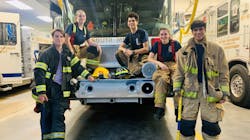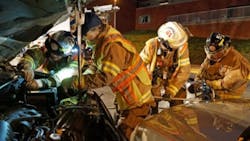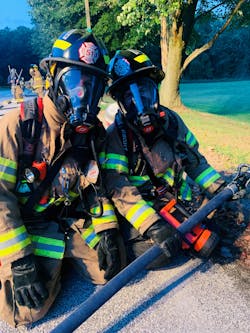Junior Firefighter Programs: Working with School Districts
The decline of volunteerism and the loss of the firehouse as a community center are problems that are felt anywhere that the volunteer fire service exists.
Compounding those problems: Volunteer fire company recruiters must compete against myriad other options for people’s time—scarcity of time tending to be the excuse for why people no longer volunteer.
To combat the graying of the volunteer firehouse, efforts focus on recruiting adolescents. This makes sense on a number of levels. To be competitive in the marketplace of the teenage mind—including to compete against sports, camp, work, college prep programs, etc., for adolescents’ time—volunteer fire company recruiters must abandon hopeful, yet often limited, word-of-mouth and open house recruiting efforts. Recruiters must pound the pavement to find teens who are strong candidates who have a clear ability to become good firefighters.
School as partner
Existing efforts to increase volunteerism in the fire service speak, in unison, of a need to connect with high schools. Despite this, few companies engage school educators to develop the level of partnership that best ensures that the right students get involved and demonstrate ownership of their service.
Without question, educators, with guidance counselors on the front line, welcome the opportunity to work with outside agencies. Unfortunately, communication with outside agencies isn’t the norm. Therefore, the volunteer fire company recruiter must promote the fire service as a viable educational and experiential option for students. This decreases the burden that might otherwise be placed on overworked school personnel. They simply can identify students who are best suited to the work and can help students break the “follow the herd” mentality, which tends to lead students to the same extracurriculars each year.
Educators are quick to relate that students ask, “What’s in it for me?” and exhibit a “Will this look good on my résumé?” mentality. This requires fire companies to articulate how the volunteer fire service will affect a student’s ability to stand out to colleges, employers and trade schools. To that end, fire company personnel must first provide appropriate information that provides details about their junior program to educators, so educators can act as gatekeeper and recommend only those students who are most likely to be a good fit.
This information might include:
- Explanation of fire company policies regarding membership qualification; expectations of junior members in terms of attendance, training, behavior and acquisition of certifications; policy regarding school days/nights and weekends; state law restrictions; financial obligations that are placed on junior members; how injuries that are sustained by junior members are handled; and how communication with parents/guardians is provided. Additional information regarding how a fire company handles stress management through utilization of critical incident stress management will prove to be of importance to educators—counselors, in particular—as they navigate the increasingly complex field of adolescent mental health issues.
- Explanation of the existing junior program, to include information on how a company program differs from a local technical school program; what quantifiable skills are expected of junior firefighters within a given year of service; how long that it takes to earn 100 hours of service (the standard for the awarding of one unit of academic credit, if academic credit is an option with a school); what physical demands are placed on junior firefighters in training and on calls; and what limitations might affect a student’s ability to become a junior firefighter.
Fire company recruiters should know that schools are bound by the Family Educational Rights and Privacy Act and might not be able to release a student’s educational, attendance and disciplinary records, which might be vital in the decision-making process of accepting a student’s application into a junior firefighter program.
Also, the volunteer fire company should have a contract between itself and parents regarding expectations of the parents. Questions that might come up include: Are parents required to attend any meetings or trainings that are associated with their child’s participation in the junior firefighter program? Are parents included in email correspondence between the volunteer fire company and junior members? Must parents respond to the station in the event that there’s a call to which the junior member isn’t able to respond? Must parents be “on call” for the duration of the time that their child is in station and/or in service? (These questions are worth asking, because many juniors join volunteer fire companies without a parent already being a member.)
To further educate school officials about the volunteer fire company, additional information is recommended:
- A tour of the firehouse, including a meeting with the chief and/or an advocate regarding the junior firefighter program
- Confirmation that members who are in contact with minor students have clearances
- A copy of the “house rules,” the junior program curriculum and state laws
- Copies of certifications that are awarded to junior members throughout the length of their class for their school file
- A written position description
- A written description of the physical and intellectual demands of volunteers at every level, with an emphasis on the paramount importance of safety in all practices
The liaison
A critical decision for volunteer fire companies, even before there’s contact at the local school, is the identification of the member who is best suited to work with the school and the recruits. Although it might be appropriate to have the training officer in the loop, the company liaison doesn’t have to be an officer—or even a member who is active on the operations side. Ideally, someone has availability during school hours to communicate with school officials in real time.
The liaison should be someone who can articulate the junior firefighter training program in which students would be engaged as well as the “business” of the fire-company-as-community-institution. Educator understanding of the role of volunteer fire companies usually is limited to alarm responses, fire drills and the activities that are conducted during Fire Prevention Week.
That said, by and large, the liaison should anticipate innocent ignorance about or, perhaps, benign indifference to the volunteer service. Thus, there will be a need to educate the educators beyond the “elevator pitch.” However, you can feel free to anticipate a receptive audience. Reflecting back on that reality of schools seeking to identify appropriate outside agencies for recommendation to students, the appointed volunteer fire company liaison is, in effect, doing the schools’ work for them.
High school pecking orders haven’t changed much since current fire service leadership was coming up. So, yes, it’s important to pursue the right candidate for the firehouse: a teen who is teachable, who has an appropriate level of physical fitness, who demonstrates a sound work ethic and who shows potential for handling the challenges that the service will present.
It also is important for the fire company to position itself for more recruits from the same school. This isn’t to say that it’s to be a popularity contest, but the teen who is described as “solid” or “consistent” or, even, “a go-getter” might be just the prototype for the junior firefighter who the company needs: The right kid in a station T-shirt might be the easiest form of recruiting that the company might ever do.
Add a few more recruits and a shared lunch hour and, suddenly, there will be a table that’s filled with young teens in station shirts from one or more companies. They might or might not come from the same social circle, but once they are a member of a firehouse, they are more likely to form a new social circle. That, in any high school, with the right mix of kids, is a recipe for a sound pipeline of recruits from freshmen to senior students.
Senior firefighters might reflect back on their own teen years and laugh about being the “odd ball,” the “rabble-rouser” or the “troublemaker.” Indeed, a recent conversation with a guidance counselor who was complimentary about the growth that was demonstrated by a particular junior firefighter revealed that the counselor believed that the academically weaker students were most likely to be drawn to the fire service.
Having that student share depth of knowledge in terms of how courses, such as chemistry, history and health, tied directly to what was taught on training nights at the station altered the counselor’s view and encouraged her to reevaluate her simplistic, inaccurate and, even, demeaning characterization of students who are drawn to the fire service. Sharing with the counselor policies about maintaining passing grades, regular attendance and avoiding disciplinary actions further solidified her understanding of the potential for a strong relationship between her office and the firehouse. What did it take? Open communication.
The liaison must be clear on what values that the company holds above others: for example, strong moral character, integrity, intellectual curiosity, task follow-through and respect for authority. In this way, a liaison can rest assured that school officials will start mentally thumbing through their Rolodex of students who are under their charge for the “right” one(s).
The wafer-thin mint
We don’t do a stellar job of “selling” the fire service. As that tradition of child-following-parent’s-footsteps has all but come to a halt, companies that are committed to continuing the tradition of volunteerism must be meaningfully proactive in creating a new tradition of recruitment.
Fans of the Monty Python comedy troupe might remember the sketch in “The Meaning of Life” in which a restaurant diner, Mr. Creosote, is offered a “wafer-thin” after-dinner mint, eats it (despite his assertion that he is “absolutely stuffed”) and promptly explodes. That tipping point exists in the volunteer service, as the existing membership has diminished significantly, while the tasks seem to have increased exponentially. Do volunteer fire companies ask members to take on just one more “wafer-thin” task? Risk those members reaching maximum density, as Mr. Creosote did? Maybe so. Nevertheless, it certainly is worth a shot.
It’s a lot of work in the beginning to sell the volunteer service as a viable opportunity for busy high school students, but once that first school year is over, the program, on the school end, should, essentially, run itself.
About the Author
Ellen Yarborough
Ellen M. Yarborough is the deputy chief at South Media Fire Company in Nether Providence Township, PA. She also is a social studies teacher who created a credit-bearing Applied Arts academic elective course that rewards students for service that they provide to three different fire companies within one school district. Now in its fourth year, the program includes a club at school, recruiting efforts at activities fairs, and visibility on school websites and the annual yearbook.


